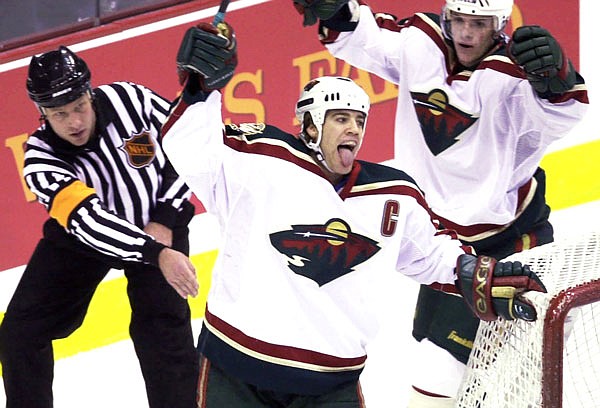ST. PAUL, Minn. (AP) - With the new franchise's prospects on the ice in front of them at the team's first rookie camp, then-Minnesota Wild general manager Doug Risebrough sat down next to director of hockey operations Tom Lynn and asked for an initial assessment.
The good news was veteran coach Jacques Lemaire looked energized in his return to the NHL bench for the 2000-01 season.
The bad?
"Well, he's got the best shot out there," Lynn quipped to Risebrough.
Such was the state of a first-year team, pieced together with experienced players the rest of the league didn't need and newbies with largely unfulfilled potential. The Wild that season had plenty of "Casey Stengel moments," Lynn's label in reference to the manager of the 1962 New York Mets. They lost 120 games in their Major League Baseball debut.
The Wild's first edition wasn't that bad, but they finished 14th out of 15 teams in the Western Conference. That was one spot behind the Columbus Blue Jackets, who with the Wild were the last clubs to enter the league until the recent award of a franchise to Las Vegas.
Next year, that yet-unnamed team will build a roster from scratch, just like the Wild and Blue Jackets did 17 years before them. Not only will Las Vegas be the first addition to the NHL in 17 years, but it will become only the third new club since then in any of the country's four most prominent professional sports leagues. Houston joined the NFL in 2002, and the NBA added Charlotte in 2004.
Las Vegas will have some advantages over Columbus and Minnesota, which followed Nashville (1998) and Atlanta (1999) in the previous wave. The salary cap floor, for one, has risen to $54 million. Columbus general manager Doug MacLean had a $17 million payroll to work with on his first roster in the pre-cap era.
The advent of analytics has given front offices more tools with which to evaluate players. There's a higher caliber of prospects reaching the league now, too, fueled by elite skills camps and national development programs.
"You're not going to have someone slip through the cracks where you're going to be rolling your eyes and going, 'Oh, how'd he end up in camp?'" said Lynn, who was promoted to assistant general manager after two seasons with the Wild and held that role for nearly seven years. He's now a player agent. "Rather than avoiding potholes, your fight will be to avoid mediocrity."
The Blue Jackets and Wild also had to fight with each other. With two teams starting simultaneously, the expansion draft pool was further diluted.
"There were very few players you really wanted," MacLean said, adding: "It was a fun process to go through, but at the end of the day you get your list and you say, 'Oh, this is it? This is it for $80 million?'"
That's what the fee was for those teams to join the league. The price tag for Las Vegas is $500 million. Thus, MacLean said, it's only fair the new franchise will start with a stronger talent base.
Columbus grabbed left wing Geoff Sanderson, a 30-goal scorer that first season, but netted little else from the expansion draft. In a nontraditional hockey market like Columbus, Blue Jackets brass felt pressure to win faster. They didn't make the playoffs until their eighth season, though, and have only qualified twice.
Minnesota, fueled by a state's rich history of high school and college programs and pickup games on frozen ponds, took a different tack. Patience was expected from a passionate fan base that lost the North Stars to Dallas in 1993. Complementing top draft picks Marian Gaborik and Nick Schultz, Risebrough focused on hard workers who would respond to Lemaire's stern, wise leadership.
"Having good character players was of the highest importance," Lynn said, "more important than their physical skills."
Darby Hendrickson, a native of Minnesota, had finished his sixth NHL season with Vancouver when he found out the Wild picked him. Fishing by himself at his lake home up north, he had some initial hesitations. The pressure of playing at home was one. The rather dim outlook was another.
"You don't know with expansion if you're going to be, like, losing every game," said Hendrickson, who's now an assistant coach for the Wild.
Hendrickson, fellow center Jim Dowd and defenseman Filip Kuba were among the players fetched in that expansion draft. By year three, they were part of a resilient team that reached the Western Conference finals.
Even in that uphill first season, highlights weren't hard to come by. The Wild beat Dallas 6-0 in their first matchup against the state's old team. The first exhibition game brought a goosebump-inducing standing ovation that still resonates with Hendrickson.
"I was just like, 'Here we go,'" Hendrickson said, "and you knew that the state was going to be behind hockey being back."

